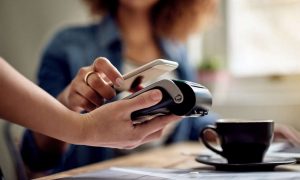Contactless payment options are nothing new. They’ve been used for close to 10 years in countries such as Australia and Canada, says Suresh Palliparambil, CEO of Purewrist, which sells a contactless payment bracelet. However, it is only in the last year or two that credit card issuers have begun to embrace the technology in the U.S. market.
“COVID drove lots of people to contactless payments,” says Jay Klauminzer, CEO of Raise, the company behind the Slide mobile payments app. He adds that adoption of these payment methods isn’t limited to younger generations either.
If you aren’t familiar with these types of payments or are concerned about their security, keep reading for everything you need to know about contactless payment options.
What Is Contactless Payment?
As their name suggests, contactless payments are those that don’t require consumers to ever hand over a card or touch a payment terminal. They are touted as being faster and more convenient … and in the age of COVID, they allow people to stand apart as well.
“The deployment of contactless payments has been crucial the past two years,” says Greg Cohen, executive chairman at FortisPay, a technology-led commerce solution. “Customers and retailers … need a safe, easy and seamless experience.”
What Types of Contactless Payments Are There?
Today, contactless payments generally fall into one of three categories:
- Contactless payment cards.
- Mobile contactless payments.
- Payment by code.
There are other methods – such as ordering online or over the phone – which are contactless as well, but discussion around contactless payments typically centers on in-store purchases.
What Is a Contactless Payment Card?
Using a method known as tap to pay, a contactless payment card eliminates the need to touch a payment terminal. This payment option requires that a retailer have a sales terminal equipped with near-field communication, or NFC, technology and that a customer have a compatible credit card. Contactless payment cards will have an antenna symbol, with four curved lines, on their front or back.
The customer taps the terminal with their card to complete the payment. Information sent by the card is encrypted and tokenized to keep data secure. That makes these transactions as safe as swiping or inserting the card into the terminal.
MSD Cards vs. Contactless EMV Cards
While they may not differ much in terms of the consumer experience, payment cards can fall into two categories:
- Magnetic strip data (MSD).
- Europay, Mastercard, Visa (EMV).
MSD cards use an older contactless technology that is largely phased out. “EMV is a global standard,” Klauminzer says. “It’s slightly more secure.”
In 2019, both Visa and Mastercard updated their contactless rules to stipulate that EMV contactless payments are the only ones to be supported by new merchant terminals going forward.
How Mobile Contactless Payment Differs From Using a Card
Mobile contactless payments rely on a mobile device, rather than a card, to complete a transaction. While all contactless payments use similar technology, adoption of mobile contactless payments lags behind that of contactless payment cards.
The 2021 Visa Back to Business Study found 62% of consumers surveyed expect to be able to tap their credit or debit card for payment. However, only 41% expect to be able to use mobile payment apps.
Kinds of Mobile Contactless Payment
Contactless payment companies have been innovative in recent years, and there are a number of ways to make payments with your mobile device. Here are the three main categories:
Mobile wallets: Apple Pay and Google Pay are among the best-known apps for contactless payments. They work in the same way as a contactless payment card, with customers tapping their device on a payment terminal.
Wearable devices: For those who don’t want to carry a phone or wallet, wearable payment devices offer convenience. Originally thought of as a way to make fitness trackers more versatile, wearable payment devices are poised to become an $82 billion global market by 2026, according to a report by MarketsandMarkets.
“We’ve just shrunk that (contactless) card and put it in a bracelet,” Palliparambil says of Purewrist. The bracelet connects to a reloadable pre-paid Mastercard and comes with a companion app so if the device is ever lost, the account can be locked immediately.
Scannable codes: Retailers and restaurants that use this method provide a QR code – also known as a quick response code – for customers to scan using their smartphone. Payment information can then be added or confirmed on the phone so no cash or card needs to change hands.
The Slide app uses a variation of that to allow customers to enter the exact amount of their purchase while at the register of participating retailers. Then, they show the cashier a code on their phone which is scanned for payment. As a bonus, purchases made with the Slide app are eligible for up to 5% cash back.
Why Are Contactless Payments So Secure?
There’s no need to worry about someone standing close to you and skimming data from your contactless payment card, Palliparambil says. “The chip and the card don’t have any power,” he explains. Instead, the card can only be read if it is very close – within one or two centimeters – to a payment terminal.
Once it is that close, the power from the terminal “wakes” up the chip and prompts it to relay data. EMV transactions also include a one-time code that adds an extra layer of security, Klauminzer says.
Beyond that, data from a contactless payment card or mobile device isn’t something that can be intercepted and deciphered without a point-of-sale device. “Any terminal that is capable of reading the credit card information needs to be registered with some merchant account,” Palliparambil says.
Even in the post-pandemic world, contactless payments are likely to continue to be popular. Nearly two-thirds of those surveyed by Visa for its 2021 Back to Business Study said they expected to use contactless payment options as often or more often in the future than they do now. Fortunately, they have plenty of choices at their disposal.
The post What Is Contactless Payment and How to Utilize This Payment Option appeared first on U.S.News
Original source: U.S.News






